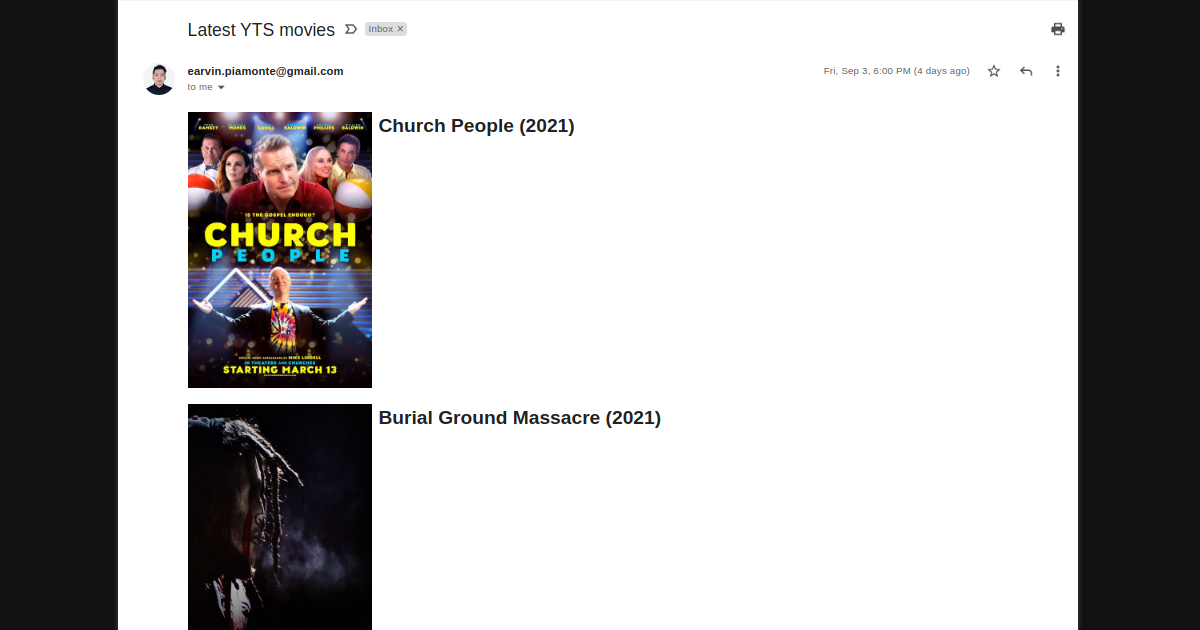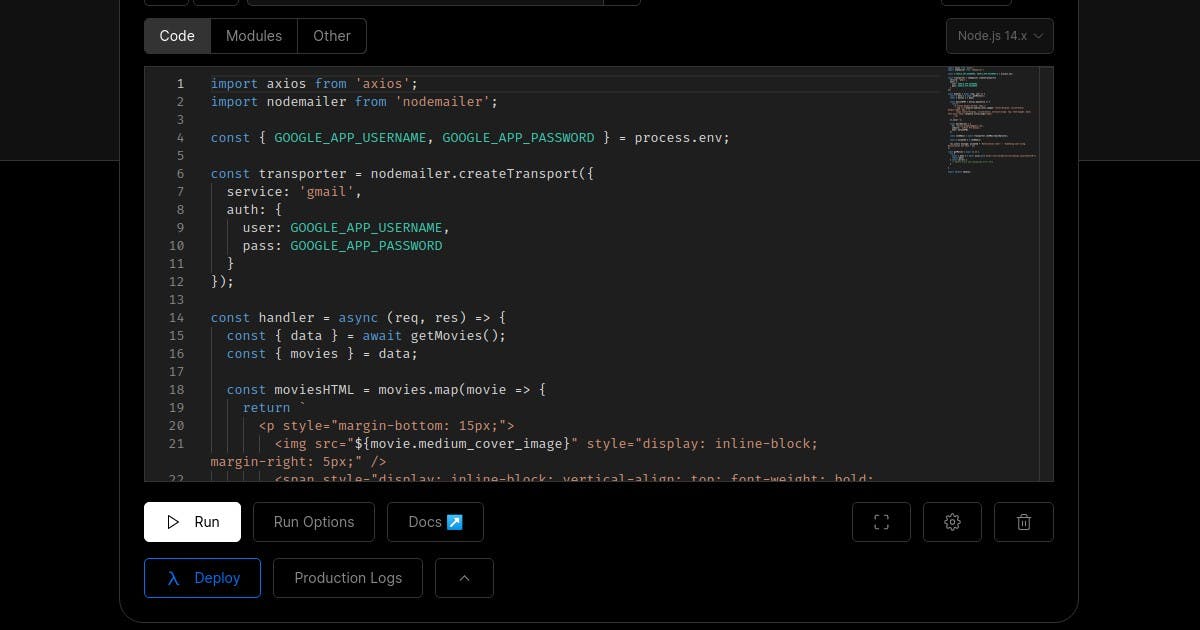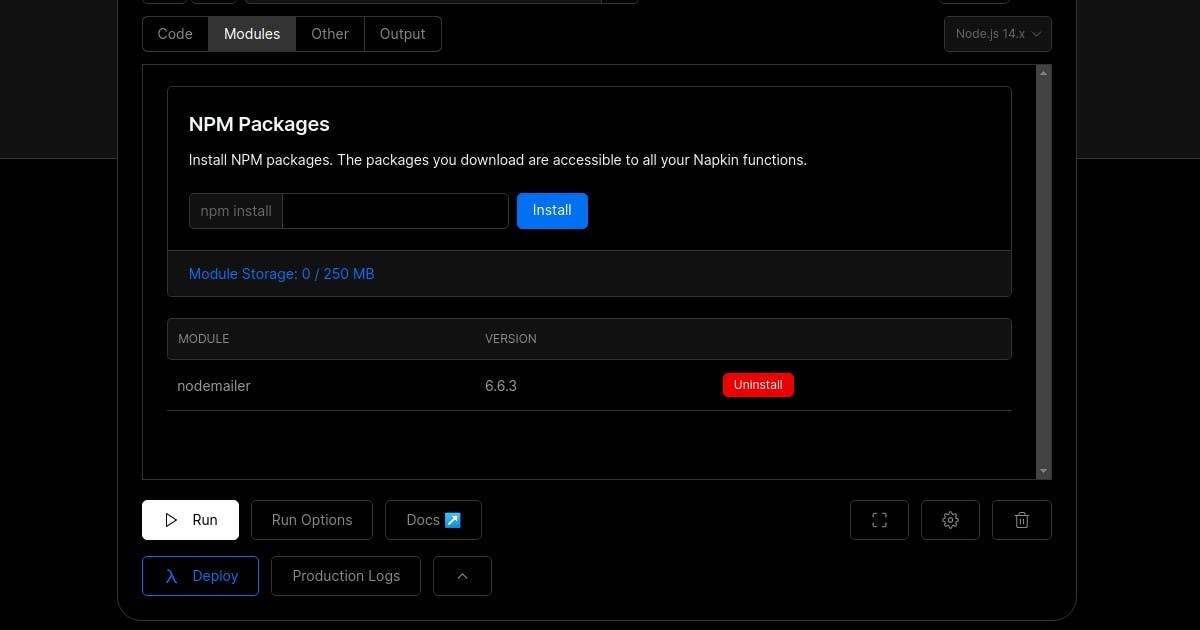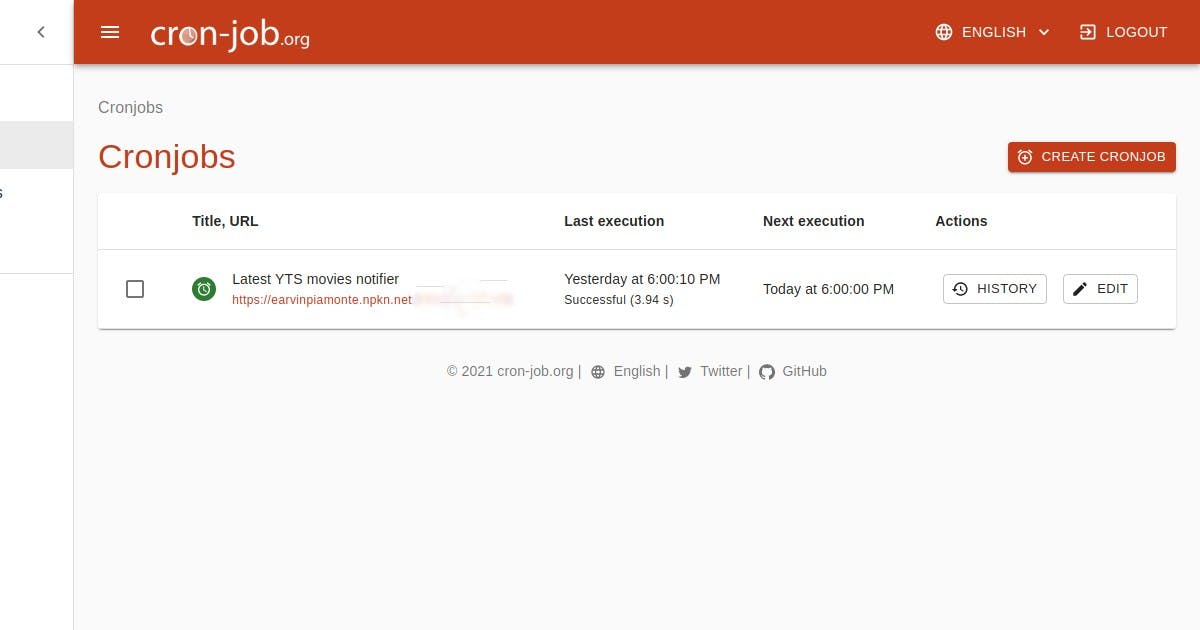post/
New Blood
September 7, 20215 min read

Node.js, Serverless, Cron Jobs
I'm sending myself an email every day at around 6PM. The content is just a list of titles of recently uploaded movies.
Warning: Downloading and distributing protected content such as movies is illegal. The script published in this post uses a public API and used solely for academic purposes only.

There are three things I set up for this to work:
- A Google app password.
- A serverless function that will send an email containing a list of recently uploaded movies.
- A cron job that will hit the URL every day at 6PM.
1. Google App Password
I prefer to receive the email notification on my personal email address and the quickest way for me was to set up a Google app password. I then use the Gmail service with the app password to send an email.
If you don't want to create an app password, because you will need 2FA enabled, you may use an email sandbox such as Mailtrap. But yeah, whatever is the easiest way to set up.
2. Serverless function
This is pretty interesting. For this part, I needed to be able to set up an API quickly that I can easily call and with less configuration as much as possible. This is where Napkin came in handy. No config. No CLI. Just a few lines of code.

It's a tool that lets you build production-ready API endpoints in minutes. Just write a function directly on the editor on a browser, hit Deploy and the URL provided is ready to be called. You may add additional path too.
Napkin supports Python and Node.js. Here's a function I built in Node.js:
import axios from 'axios';
import nodemailer from 'nodemailer';
const { GOOGLE_APP_USERNAME, GOOGLE_APP_PASSWORD } = process.env;
const transporter = nodemailer.createTransport({
service: 'gmail',
auth: {
user: GOOGLE_APP_USERNAME,
pass: GOOGLE_APP_PASSWORD,
},
});
const handler = async (req, res) => {
const { data } = await getMovies();
const { movies } = data;
const moviesHTML = movies
.map((movie) => {
return `
<p style="margin-bottom: 15px;">
<img src="${movie.medium_cover_image}" style="display: inline-block; margin-right: 5px;" />
<span style="display: inline-block; vertical-align: top; font-weight: bold; font-size: 24px;">${movie.title_long}</span>
</p>
`;
})
.join('');
const mailOptions = {
to: 'earvin.piamonte@gmail.com',
subject: 'Latest YTS movies',
html: moviesHTML,
};
const sendEmail = await transporter.sendMail(mailOptions);
const { accepted } = sendEmail;
res.json({
message: accepted
? 'Notification sent!'
: 'Something went wrong. Notification not sent.',
});
};
const getMovies = async () => {
try {
const { data } = await axios.get(
'https://yts.mx/api/v2/list_movies.json?limit=10'
);
return data;
} catch (error) {
// Handle axios and unexpected error here
}
};
export default handler;
So what does it do?
- It gets the latest 10 movies from YTS with the
getMovies()function. - It formats the data into HTML which includes the movie cover and title.
- It sends an email to myself using
nodemailer.
One cool feature of Napkin is that it comes with various pre-installed NPM packages such as axios and cheerio so you don't have to install them manually even though installing packages is as easy as providing the package name and hitting the Install button that can be done on the "Modules" tab of the editor.

Deep dive into the code:
The only package I installed is nodemailer. The axios package comes pre-installed as I recently mentioned.
I unpacked the environment variables I created, namely GOOGLE_APP_USERNAME and GOOGLE_APP_PASSWORD from the built-in process.env global property.
createTransport() is a method of nodemailer that takes an object that defines connection data.
There are two functions on this script. One is handler() and the other is getMovies(). The handler() function is the one that gets called when the API is hit. This can be named anything as long at as it's exported. The getMovies() function fetches the data from YTS.
sendMail() method returns a Promise object if the callback argument is not provided. Who uses a callback in 2021? Just kidding. hahaha.
Lastly, I'm returning a message with res.json() just to send a response to the client.
3. Cron job
Now that I have a function that sends an email containing a list of movies, the last step is to have a cron job that hits the API everyday at 6PM. I used cron-job.org for this. It's a platform to set up cron jobs for free. Check out their FAQ for more information.

The task runs about 3 to 4 seconds based on the execution history.
With these free tools, it's now easier to try out things and even build small production ready applications in a short amount of time.
Napkin is relatively new and I'm excited what comes next. Here's a thread on Hacker News that's probably worth a read.